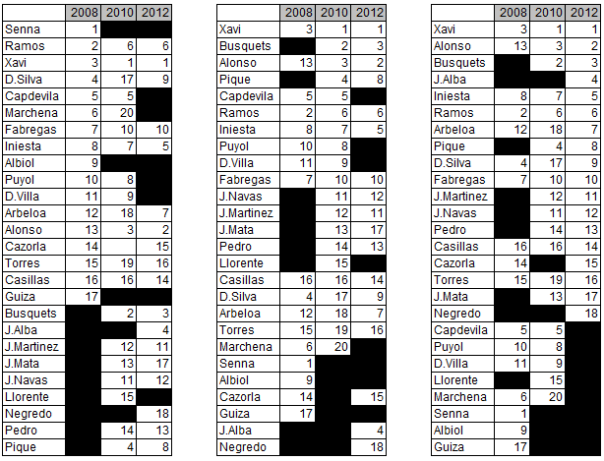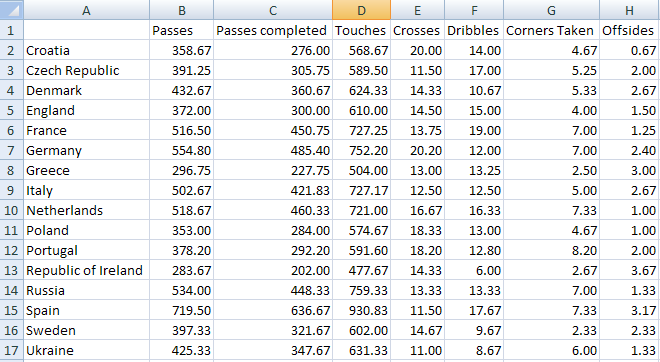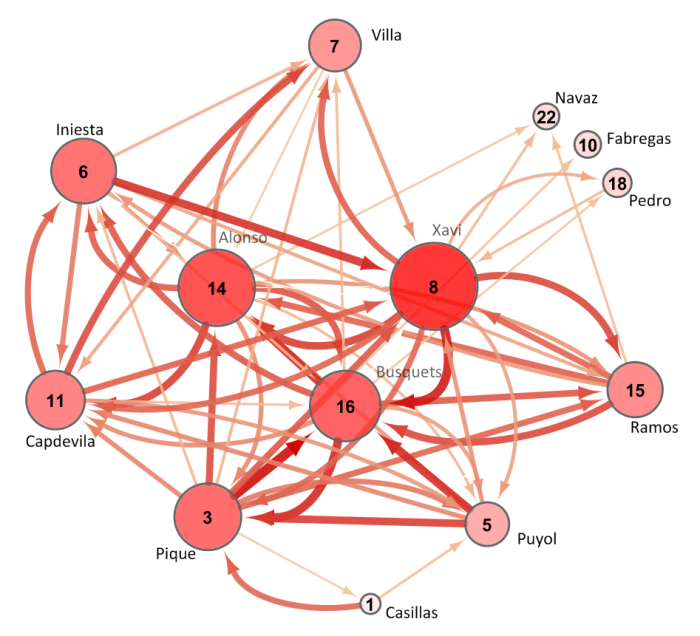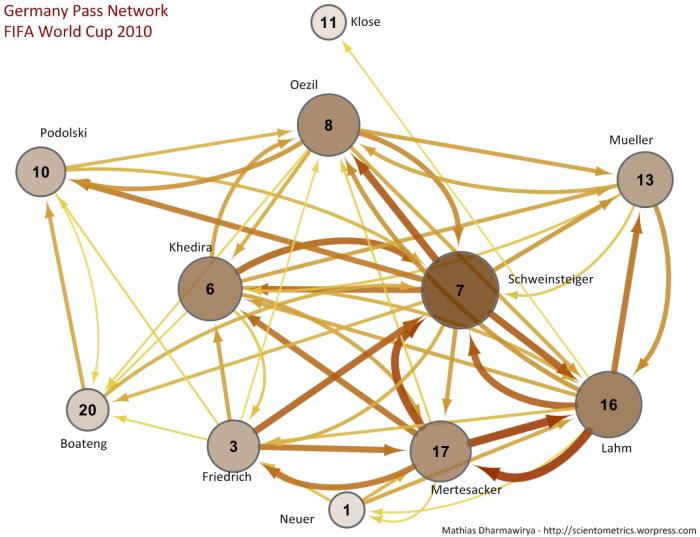Most Important Player in the Spanish Team from 2008 to 2012 tournaments
Below is the rank of importance among Spanish players in the EURO 2008, FIFA World Cup 2010, and EURO 2012. The rank is based on the number of touches in the game (i.e. the number of outgoing AND incoming passes of each player). The calculation is done in R, thanks to Tore Opsahl’s tnet package.
Note: In the tnet package, the alpha that I used was 0.5.
Written by Mat
March 16, 2013 at 9:44 am
Posted in Uncategorized
Tagged with R, SNA, Soccer, Social Network Analysis, Spain, tnet
Barcelona vs AC Milan Passing Distribution (2nd Leg)
Some changes can be noticed clearly when the passing distribution in the 2 legs are compared. Here is the link to the first leg passing distribution.
- With David Villa playing rather than Fabregas, Messi could drop deeper and work more cohesively with Xavi and Iniesta.
- Moving Pedro to the left seems to be a fruitful decision too. First, Alves can work directly with Messi once again and at the same time Jordi Alba is “forced” to be more discipline defensively (i.e. doesn’t need to overlap very often as Pedro is already there). This impact can also be seen in AC Milan passing distribution in the two legs. See how Abate-Boateng thick link in the first leg is no longer present in the 2nd leg (replaced by Constant-Shaarawy link).
Written by Mat
March 13, 2013 at 10:19 am
Posted in Social Network Analysis
Tagged with AC Milan, barcelona, SNA, Soccer, Social Network Analysis
Euro 2012 Multidimensional Scaling Analysis
Based on OPTA’s data (via footytube), below is the multidimensional scaling plot based on per game data of passes, passes completed, touches, crosses, dribbles, corners taken, and offsides.
I was using Classic Multidimensional scaling, from wiki:
Multidimensional scaling (MDS) is a set of related statistical techniques often used in information visualization for exploring similarities or dissimilarities in data.
Also known as Principal Coordinates Analysis, Torgerson Scaling or Torgerson–Gower scaling. Takes an input matrix giving dissimilarities between pairs of items and outputs a coordinate matrix whose configuration minimizes a loss function called strain.
Based on the figure below, it is indicated that Germany and Netherland should have similarities, the same can be said with Ukraine, Czech, and Sweden. However, as far as my memory goes in watching the Euro 2012 games, I failed to notice how the teams are similar. In addition, what should be the label for the x and y dimensions?
Any comment?

Note: The input matrix in this case is as shown below and can be downloaded here.
Written by Mat
March 6, 2013 at 12:18 pm
Posted in Social Network Analysis
Tagged with EURO 2012, SNA, Soccer, Social Network Analysis
Barcelona vs AC Milan Passing Distribution
Written by Mat
February 21, 2013 at 10:48 am
Posted in Uncategorized
Tagged with Soccer, Social Network Analysis
Munchen vs Madrid Passing Distribution
Didn’t watch the match, but have been reading how Toni Kroos played an important role in the match. Based on the graph, he IS quiet central for Munchen in the match.
Some notes:
- Why were there so many passes by Alonso to both central defenders Ramos and Pepe?
- Centrao-Arbeola and Alaba-Lahm have similar passing distribution towards their central defenders (backward pass), but see how they differ in terms of forward passes.
Written by Mat
April 20, 2012 at 12:45 pm
Posted in Social Network Analysis
Tagged with Cytoscape, Kroos, Madrid, Munchen, passing distribution, Soccer, Social Network Analysis
Chelsea vs Barcelona Passing Distribution
Which side is Barcelona?

Chelsea vs Barcelona Passing Distribution
The number of passes by all Chelsea players: 194.
The number of passes by all Barcelona players: 779 (Xavi alone completed 127 successful passes and received 133 passes!).
Ball Possession: Chelsea 28% – 72% Barcelona.
But, the most important fact is still Chelsea 1, Barcelona 0.
Written by Mat
April 19, 2012 at 4:09 pm
Posted in Social Network Analysis
Tagged with barcelona, chelsea, Soccer, Social Network Analysis
Most Productive Authors in JASIST
Timeframe: Dec 2001 (JASIST vol 52, No. 14) – July 2011 (JASIST vol 62, No. 7)
Two types of counting method are used:
- Whole count: Each author receive a credit with a count of 1.
- Fractional count: Here, if a publication is authored by N number of authors, each author receive credit with a count of 1/N.
Source: ISI Web of Knowledge
Written by Mat
July 17, 2011 at 10:31 am
Posted in Scientometrics
Tagged with JASIST, Scientometrics
Preview: Netherlands vs Spain
Netherlands:
Spain:
Few notes:
- This match may be more tightly contested than Spain vs Germany. This is because Netherlands, unlike Germany, does not have an over reliance towards a single player (like Schweinsteiger in Germany). So, it might be tougher for Spain to dominate the possession like it did against Germany.
- On another note, Netherlands past view goals have been due to Sneijder’s geniuses. So, if Spain can take care of Sneijder, Netherlands possibility to score should be minimized.
Written by Mat
July 11, 2010 at 9:49 pm
Posted in Social Network Analysis
Tagged with Cytoscape, FIFA, Netherlands, Soccer, Social Network Analysis, Spaing, World Cup
Germany Pass Network (aggregated from all matches)
Notes:
- To prevent the network becoming too cluttered, an edge is only shown when its weight is greater than or equal to 15.
- Thanks to JJ Merelo for the data.
Written by Mat
July 11, 2010 at 8:26 pm
Posted in Social Network Analysis
Tagged with FIFA, Germany, Soccer, Social Network Analysis, World Cup
Xavi pass-network (ESP 0:1 SUI)
Throughout the five games Spain has played in the 2010 FIFA World Cup, Xavi has been one of its most important player. He has passed the ball more than anyone else in his team, and also more than anyone else in the World Cup (up to quarter final stage). He has passed the ball 464 times (92 times/game) with a passing accuracy of 80%.
If we look at the authority centrality in Spain team, Xavi has always been among the top 2 most central player in his team. This is the definition of authority-centrality from ORA:
A node is authority-central to the extent that its in-links are from nodes that have many out-links. Individuals or organizations that act as authorities are receiving information from a wide range of others each of whom sends information to a large number of others. Technically, an agent is authority-central if its in-links are from agents that have are sending links to many others. The scientific name of this measure is authority centrality and it is calculated on agent by agent matrices.
In other word, Xavi is authority central because he received passes from other players who passes the balls a lot (i.e. played the distributor role in the team).
Let’s visit Xavi passing game during Spain’s first game against Swiss (which it lost).
*The size of the jersey indicates the authority-centrality of each player.
The thickness of the line indicates the frequency of passes between Xavi and the other player. Very interestingly, Xavi only passed the ball successfully to David Villa 3 times throughout the whole game. This fact is even more surprising since Torres only came into play in minute 61 replacing Busquets (note: Xavi did not have any successful pass towards Torres in this game). As a comparison, in Spain subsequent games where Torres played the game from the beginning, Xavi had 5 completed passes towards Villa (vs Honduras), 5 (vs Chile), 18 (vs Portugal), and 8 (vs Paraguay). And successful passes towards Torres are: 3 (vs Honduras), 1 (vs Chile), 5 (vs Portugal), 2 (vs Paraguay).
It can also be observed the preference of Xavi to pass towards Iniesta rather than to David Silva. And also he passed the ball more often to Sergio Ramos rather than to David Silva. David Silva is definitely a competent player, but it doesn’t seem he meshed well during the match. And Xavi (one of Spain most influential player) seemed not very comfortable playing along with him (indicated from the number of passes among them). Guess what, this match against Swiss was the first and also the last game (upto quarter final) for David Silva. He did not even enter other matches as a substitute.
There could be other reasons why David Silva has not played since the match against Swiss. But this could be an analogy in an organization setting. Talent alone may not guarantee a place in an organization, one should make sure he/she can mesh together with other team member (especially with the influential people in the organization.)
Written by Mat
July 6, 2010 at 6:28 pm
Posted in Social Network Analysis
Tagged with Soccer, Social Network Analysis, Spain, Swiss, World Cup









